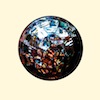 There have been few albums that I remember waiting so impatiently for. Several years have gone by since Clodagh Simonds' first transmission under the Fovea Hex umbrella and finally a full length has appeared. Continuing on from an exceptional string of EPs and singles, Here is Where We Used to Sing finds Simonds and her ever shifting group exploring different aspects of their songwriting process. With more focused lyrics and more defined melodies, their music has solidified and began to sprout sharp, beautiful forms like crystals grown in a petri dish: equally perfect and fragile.
There have been few albums that I remember waiting so impatiently for. Several years have gone by since Clodagh Simonds' first transmission under the Fovea Hex umbrella and finally a full length has appeared. Continuing on from an exceptional string of EPs and singles, Here is Where We Used to Sing finds Simonds and her ever shifting group exploring different aspects of their songwriting process. With more focused lyrics and more defined melodies, their music has solidified and began to sprout sharp, beautiful forms like crystals grown in a petri dish: equally perfect and fragile.
After waiting so long for a full album from Fovea Hex, I must admit I had some trepidations about Here is Where We Used to Sing. What made the three EPs that made up Neither Speak Nor Remain Silent was their blend of song craft and a loose, magical slipping of the sounds through the cracks in the melodies. The same alchemy did not seem to permeate Here is Where We Used to Sing to the same extent; the main album is very much anchored to the piano and the more experimental sequences are saved for the bonus disc, Three Beams. Initially, I was perturbed by this segregation of what I felt to be Fovea Hex's defining feature but the more I listen to the album, the more I fall in love with it. The shifts and wobbles are still there but they are subtler now, a deeper engagement with the music is needed.
It is not just the music that has a poetic depth to it, the renaissance of mysticism in Ireland in the early 20th century by the likes of W.B. Yeats and Æ finds a descendant in Simonds' words (both now and throughout her career). Simonds' lyrics at once capture the ordinary in all its vivid realism and also the layers on top of this normality that fill out a dull scene into an astonishing and beautiful epiphany. A fitting example being these lines sung by Laura Sheeran on "Falling Things (Where Does a Girl Begin?)":
"You might recall some sunny day this other day of falling things
Raising your face… And then I might fall calling your name as I'm streaming by."
The music and the words come together as a powerful concoction, soporific and hypnogogic. This is particularly true of the album’s stunning centerpiece, "A Hymn to Sulphur," which marries Simonds and Sheeran's sea-drenched vocals with a tidal rhythm of e-bowed guitar, strings, and piano. An intermittent piano pulse played on the higher notes sounds like a submarine's sonar, completing the oceanic setting. On the violin and cello respectively, Cora Venus Lunny and Julia play with a power and grace that illuminates the other elements of the song, highlighting and accentuating the vocals in particular.
The remainder of Here is Where We Used to Sing is no less sublime. Short instrumental pieces punctuate the album and Michael Begg and Colin Potter both help create these little tableaus (as well as adding to the main songs), their touch apparent but not heavy. Their contributions involve blurring the boundaries within the music; instruments seep into each other and form new, striking shapes. Other previous Fovea Hex collaborators reappear throughout the album, Brian Eno and Fabrizio Palumbo both being particularly noteworthy for their ethereal electronics and guitar respectively.
Begg, Potter, and William Basinski rework the recordings on the Three Beams disc and all three come up with startling results. Both Begg and Basinski create haunting, abstract soundworks out of the raw materials. Begg takes the strings and turns them into shooting stars, it feels like the notes are hurtling past my ears. On the other hand, Basinski's treatment of the music sounds more like glass birds in a giant, reverberating aviary. However, it is Potter's contribution that captivates me entirely. Moving on an arc through the album's rich ingredients, he is the only one of the three to use the vocals as a central point in his own composition. Potter's construction of the music gives the whole piece a bell-like character; he picks up on the music's resonances and expands the songs into vast stretches of glorious space. When Simonds and Sheeran call out through the ether, it feels like a bolt of lightning from God.
While I never expected to be disappointed with Here is Where We Used to Sing, I also never expected it to confound my expectations to this degree. I feel like I still have only scratched the surface of this work; like the Neither Speak Nor Remain Silent EPs, this is an album that will keep revealing secrets with every listen.
samples:
- A Hymn to Sulphur
- Still Unseen
- Cup of Joy (Colin Potter)
 
Read More


